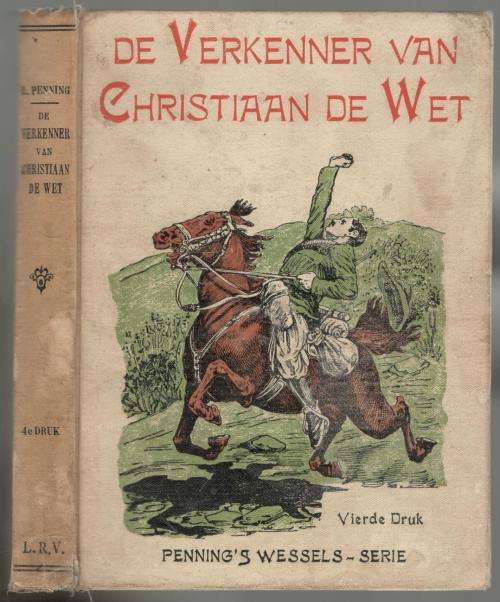De ‘verre neven’ in Zuid-Afrika
De straatnamen van de Leidse Transvaalwijk hebben gemeen dat ze bijna allemaal – met uitzondering van enkele straten zoals de Lopsenstraat en de Morskade en -weg – verwijzen naar historische figuren die in de Eerste en Tweede Boerenoorlogen in Zuid-Afrika (respectievelijk 1880-1881 en 1899-1902) tegen het Britse Rijk hadden gevochten.
Deze oorlogen maakten grote indruk in Nederland. Tegen ieders verwachting in, wisten de Boeren de Engelsen te verslaan tijdens de Eerste Boerenoorlog. Nadat de Boeren weer vergeten waren geraakt, werd er door de overwinning een zekere verbondenheid gevoeld met deze afstammelingen van de Nederlandse kolonisten, die zich onder leiding van Jan van Riebeeck in de zeventiende eeuw in Zuid-Afrika hadden gevestigd. Door het hele land werden de Boeren gesteund in hun strijd. Zo verschenen er propagandistische kinderboeken en liederen waarin hun ‘heldhaftigheid’ werd gevierd (Fig 1). Ook werden er in tientallen steden verschillende straten vernoemd naar Boerenleiders, helden in de ogen van veel Nederlanders toen. (Fig 2, 3 & 4).
Nederlanders voelden zich dus verbonden met deze Afrikaanse verre neven. Deze band noemde men toen ook wel het stamverwantschap. Overigens had deze verbondenheid weinig praktische gevolgen. Vrijwilligers en verplegers gingen meedoen met de Boeren, er kwamen donaties op gang en verschillende Nederlanders, waaronder de jonge koningin Wilhelmina, probeerden de Britten van gedachten te veranderen. Maar echt grote acties, zoals officiële troepen sturen naar Zuid-Afrika, ontbraken. Hiervoor waren de Britten veels te sterk en Nederland wilde immers niet zijn veel lucratievere kolonie Nederlands-Indië (Indonesië) verliezen.
In Engeland was het oorlogsenthousiasme net zo groot, maar was het enthousiasme gericht op de tienduizenden eigen Britse soldaten. Alle grote koloniën leverden troepen en ook de Engelse bevolking te helpen via donaties en door mee te vechten. In de kranten werd heel positief geschreven over de Britten, terwijl de Boeren van van alles werden beschuldigd. En ook van veel Engelsen die aan de Tweede Boerenoorlog hebben deelgenomen kennen we nu nog de naam. Zo hielpen Mahatma Gandhi en Arthur Conan Doyle (de schrijver van James Bond) als verpleger, reisde Winston Churchill als journalist en militair rond en vormde koning Victoria het gezicht van de Britse macht. Een feminist als Emily Hobhouse kwam dan juist weer in opstand tegen de inzet van vele concentratiekampen door de Britten.
Overal in Nederland zijn dus Reitzstraten te vinden, maar toch is er iets geks aan de hand met de Reitzstraat in Leiden. Die vernoeming vond namelijk pas plaats in 1920, lang na de Boerenoorlog. De naam die de straat daarvoor droeg was …. Marialaan. Ja precies! Een vrouwennaam!
Wil je weten hoe de straatnamen in de Leidse Transvaalbuurt aan hun naam zijn gekomen? Lees dan hieronder verder!
](https://micrio.thingsthattalk.net/GsUVr/views/max/128x128.jpg)
](https://micrio.thingsthattalk.net/kRAPP/views/max/179x128.s.jpg)
](https://micrio.thingsthattalk.net/jYxTz/views/max/146x128.s.jpg)
](https://micrio.thingsthattalk.net/EQjKU/views/max/151x128.s.jpg)
](https://micrio.thingsthattalk.net/yQYoX/views/max/214x128.s.jpg)
](https://micrio.thingsthattalk.net/dUnUy/views/max/195x128.s.jpg)